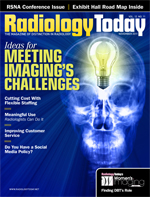 November 2011
November 2011
The ALARA Principle and Sonography
By Beth W. Orenstein
Radiology Today
Vol. 12 No. 11 P. 10
No one has ever reported adverse reactions from performing sonograms on humans. But researchers have seen sonograms cause negative health effects for laboratory mice.
Phillip Bendick, PhD, RVT, FDMS, technical director of the Peripheral Vascular Diagnostic Center and director of surgical research at William Beaumont Hospital in Royal Oak, Mich., told sonographers attending the Society of Diagnostic Medical Sonography’s annual conference in Atlanta in September that they must understand how to scan safely so they are not the first to report adverse bioeffects from performing sonograms on people.
“It’s out there,” Bendick said. “It just hasn’t happened yet. Just because it hasn’t happened doesn’t mean you shouldn’t worry. It doesn’t mean it can’t or won’t [happen].”
Bendick said the concern over the safety of sonography is growing because of technological advances made in ultrasound equipment over the last decade or so and the increasing use of sonograms, especially in obstetrics and especially in the first trimester, when a fetus is most vulnerable. The issue is that transducers produce heat, and “hyperthermia is a bad thing, particularly in the womb,” he noted. A major heat-absorbing structure in a fetus is the spine, which is near sensitive neurologic and vascular structures. “You need to think about that and take that into account when you’re scanning a fetus,” Bendick said.
Ultrasound also can cause small gas bubbles to form in liquids, which could pose a threat when scanning the lungs and small blood vessels.
Compared with 20 to 30 years ago, Bendick said, the FDA has raised the amount of power that can be transmitted during diagnostic medical sonography. “If you put more power into the body, more can be absorbed,” he said, noting that the research isn’t clear yet regarding what effect the higher absorption rates may have, but it could be negative.
Bendick told the attending sonographers he’s convinced that when—not if—the first bioeffects from sonograms are reported in humans, it’s going to be tragic. “You take a perfectly healthy fetus and overexpose it to ultrasound acoustic heat and any number of things can happen,” he said.
That’s why, Bendick said, sonographers must understand how to scan safely and adopt the practice of ALARA (as low as reasonably achievable) more commonly associated with exams involving ionizing radiation.
Ultrasound equipment manufacturers now report two indexes on their machines that require a sonographer’s attention, he said, noting it has been an FDA requirement since the late 1990s. One is the mechanical index (pressure fluctuations) and the other is the thermal index.
“The higher the mechanical index, the greater potential for damage,” he said. “A mechanical index of greater than 0.3 could cause capillary bleeding in the lungs. A mechanical index greater than 0.7 could cause true cavitation—damage caused by the formation of bubbles—in the tissue.” The FDA stipulates that the diagnostic medical sonography equipment mechanical index cannot exceed 1.9.
Bendick said sonographers should know where the mechanical and thermal indexes are on the ultrasound equipment they use and pay attention to the numbers when they scan. Also, he said, sonographers should minimize the amount of time they spend scanning when possible.
“Time is of the essence,” he said. “Try to limit dwell time.”
If more scanning time is needed, break it up. “Do the study you need to do as a sonographer but break it up into smaller components so that you’re not dwelling on the tissue, especially if it’s fetal tissue,” he said.
And keep the acoustic output as low as possible. “Follow the Goldilocks theory. You don’t want too much acoustic output or too little but just the right amount,” he said. “If the image is too bright, turn down the acoustic output. You don’t need that much power.”
Bendick said a good habit to get into is turning down the acoustic output when an exam is completed. “That way the next person to use the machine will start at the lower acoustic output,” he noted.
The onus is on the sonographers because “you’re the one operating the machine and getting the feedback from the displays.”
It’s important that sonograms be performed only when absolutely necessary, Bendick said, acknowledging that sonographers don’t order exams. Bendick said physicians should always ask, “‘Is this test medically necessary?’ If there’s no benefit to a test you order, no risk, no matter how small, is acceptable.”
Bendick said he wasn’t trying to scare anyone but rather attempting to make sonographers aware that while there have been no reported adverse effects related to diagnostic medical sonography in humans, “the potential for these to occur exists.”
— Beth W. Orenstein is a freelance medical writer based in Northampton, Pa. She is a frequent contributor to Radiology Today.

